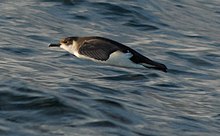Barolo shearwater
| Barolo shearwater | |
|---|---|

| |
| Scientific classification | |
| Kingdom: | Animalia |
| Phylum: | Chordata |
| Class: | Aves |
| Order: | Procellariiformes |
| Family: | Procellariidae |
| Genus: | Puffinus |
| Species: | P. baroli
|
| Binomial name | |
| Puffinus baroli | |
The Barolo shearwater (Puffinus baroli), also known as the North Atlantic little shearwater or Macaronesian shearwater, is a small shearwater which breeds in the Azores and Canaries of Macaronesia in the North Atlantic Ocean. Puffinus is a New Latin loanword based on the English "puffin" and its variants, such as poffin, pophyn and puffing,[2] that referred to the cured carcass of the fat nestling of the Manx shearwater, a former delicacy. The specific baroli refers to Carlo Tencredi Falletti, marquis of Barolo.[3]
Taxonomy[]
It was previously considered conspecific with the little shearwater (Puffinus assimilis) of the Southern Hemisphere. Mitochondrial DNA cytochrome b sequence analysis (Austin et al., 2004) indicates, however, that baroli and boydi are very close to the nominate subspecies of Audubon's shearwater. Whether the morphological distinctness and the non-overlapping ranges, or the genetic similarity[4] are considered to be more significant is a matter of opinion, and the taxonomic status of these birds remains equivocal. Although some institutions (such as BirdLife International) retain the forms baroli and boydi within little shearwater, this is as a result of inaccurate lumping in the past, and is not supported by modern evidence. The British Ornithologists' Union has accepted P. baroli as a distinct species (Sangster et al. 2005), as has Clements Checklist. The American Ornithologists' Union followed in 2013.[5]
Description[]
Features that distinguish the Barolo shearwater from the Manx shearwater and other North Atlantic Puffinus species include the pale face, silvery panel in the upperwings, shorter more rounded wings, and blue feet.[6] As well as the pale face with the darkly contrasting eye.[7]
Distribution[]
The Barolo shearwater occurs in the Macaronesian Islands and breeds on the Azores, Desertas, Selvagens and Canary islands.[1] The largest colony, of 1400 pairs, occurs on the Selvagen Islands.[8]
Habits[]
The Barolo shearwater feeds in the upper 15m of the water column, which is similar to the closely related Audubon's shearwater Puffinus lherminieri of the western Atlantic and Caribbean Sea. Barolo shearwaters do not have a preferred time of day to forage or rest and they may hunt for food during either day or night, although they seem to be more ready to fly in the daylight hours. They feed mainly on fish and cephalopods, with Argonauta argo being the most common cephalopod taken in the Azores but also being part of a diverse selection of cephalopod prey, while the fish taken were almost exclusively Phycis spp.[9]
Threats[]
Like other Procellariforms, introduced predators (rats and cats) must be their main threats at breeding colonies. In addition, fledglings are attracted to artificial lights at night during their maiden flights from nests to the sea.[10] On Tenerife, Canary Islands, a decline on the number of birds attracted to lights have been reported, suggesting a population decline on the island.[11]
References[]
- ^ Jump up to: a b "Barolo Shearwater Puffinus baroli Bonaparte, 1857". Avibase. Denis Lepage. Retrieved 10 December 2016.
- ^ "Puffin". Oxford English Dictionary. Oxford University Press. Retrieved 14 December 2014.(subscription required)
- ^ Jobling, James A (2010). The Helm Dictionary of Scientific Bird Names. London: Christopher Helm. pp. 67, 323. ISBN 978-1-4081-2501-4.
- ^ Note that mtDNA is of somewhat dubious value for species-level taxonomic revisions in Procellariiformes, due to these birds' long lifespan and some genetic peculiarities. See also Rheindt & Austin (2005).
- ^ "Articles - Seabird splits". Birdwatch. Archived from the original on 2016-11-12. Retrieved 2016-11-11.
- ^ McGeehan & Mullarney 1995, Martin & Rowlands 2001.
- ^ "Barolo's Shearwater Puffinus baroli (Bonaparte, 1857)". Wind Birds, Lda. 2005-10-07. Retrieved 10 December 2016.
- ^ "Macaronesian Shearwater (Barolo Shearwater)". www.birdsandcompany.com. Retrieved 10 December 2016.
- ^ Verónica C. Neves; Joël Bried1; Jacob González-Solís; Jose L. Roscales; Malcolm R. Clarke (2012). "Feeding ecology and movements of the Barolo shearwater Puffinus baroli baroli in the Azores, NE Atlantic" (PDF). Marine Ecology Progress Series. 452: 269–285. doi:10.3354/meps09670.
- ^ Rodríguez, Airam (2009). "Attraction of petrels to artificial lights in the Canary Islands: effects of the moon phase and age class". Ibis. 151 (2): 299–310. doi:10.1111/j.1474-919X.2009.00925.x. hdl:10261/45133.
- ^ Rodríguez, Airam (2012). "Trends in numbers of petrels attracted to artificial lights suggest population declines in Tenerife, Canary Islands". Ibis. 154: 167–172. doi:10.1111/j.1474-919X.2011.01175.x. hdl:10261/45113.
External links[]
- Puffinus
- Birds of Macaronesia
- Birds described in 1857
- Taxa named by Charles Lucien Bonaparte